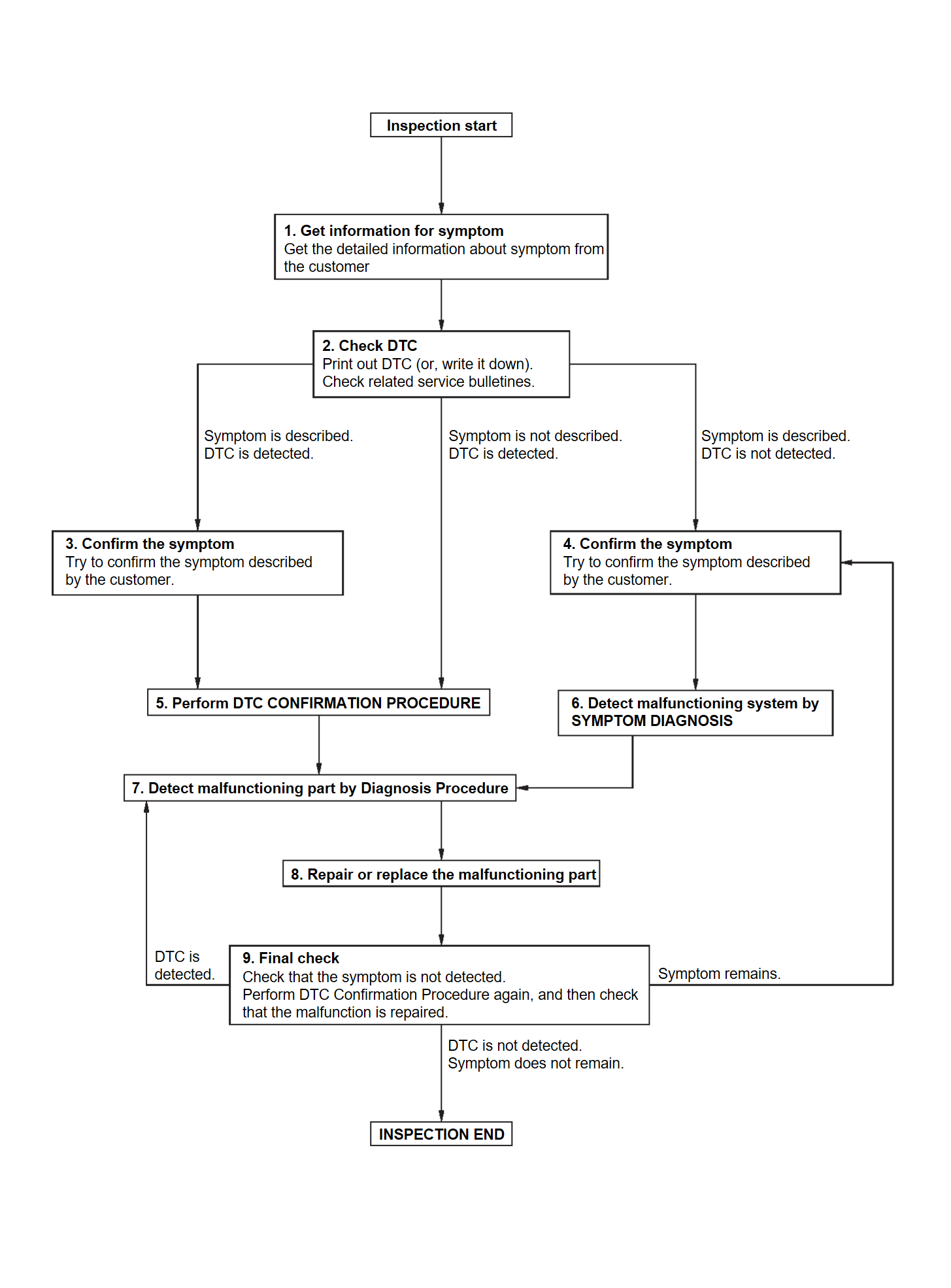Work Flow
DETAILED FLOW
1.GET INFORMATION FOR SYMPTOM
- Get detailed information from the customer about the symptom (the condition and the environment when the incident/malfunction occurs).
- Check operation condition of the function that is malfunctioning.
2.CHECK DTC
- Check DTC.
- Perform the following procedure if DTC is detected.
- Record DTC (Print them out using M.U.T.-III SE).
- Erase DTC.
- Study the relationship between the cause detected by DTC and the symptom described by the customer.
- Check related service bulletins for information.
Are any symptoms described and any DTC detected?
3.CONFIRM THE SYMPTOM
Try to confirm the symptom described by the customer.
Verify relation between the symptom and the condition when the symptom is detected.
4.CONFIRM THE SYMPTOM
Try to confirm the symptom described by the customer.
Verify relation between the symptom and the condition when the symptom is detected.
5.PERFORM DTC CONFIRMATION PROCEDURE
Perform DTC CONFIRMATION PROCEDURE for the detected DTC, and then check that DTC is detected again. Check according to Intermittent IncidentIntermittent Incident
Check according to Intermittent IncidentIntermittent Incident .
.
Is DTC detected?
 Check according to Intermittent IncidentIntermittent Incident
Check according to Intermittent IncidentIntermittent Incident .
.6.DETECT MALFUNCTIONING SYSTEM BY SYMPTOM DIAGNOSIS
Detect malfunctioning system according to SYMPTOM DIAGNOSIS based on the confirmed symptom in step 4, and determine the trouble diagnosis order based on possible causes and symptom.
7.DETECT MALFUNCTIONING PART BY DIAGNOSIS PROCEDURE
Inspect according to Diagnosis Procedure of the system. Check according to Intermittent IncidentIntermittent Incident
Check according to Intermittent IncidentIntermittent Incident .
.
Is malfunctioning part detected?
 Check according to Intermittent IncidentIntermittent Incident
Check according to Intermittent IncidentIntermittent Incident .
.8.REPAIR OR REPLACE THE MALFUNCTIONING PART
- Repair or replace the malfunctioning part.
- Reconnect parts or connectors disconnected during Diagnosis Procedure again after repair and replacement.
- Check DTC. If DTC is detected, erase it.
9.FINAL CHECK
When DTC is detected in step 2, perform DTC CONFIRMATION PROCEDURE again, and then check that the malfunction is repaired securely. -1
-1 .
. -2
-2 .
. Before returning the vehicle to the customer, always erase DTC.
Before returning the vehicle to the customer, always erase DTC.
When symptom is described by the customer, refer to confirmed symptom in step 3 or 4, and check that the symptom is not detected.
Is DTC detected and does symptom remain?
 -1
-1 .
. -2
-2 .
. Before returning the vehicle to the customer, always erase DTC.
Before returning the vehicle to the customer, always erase DTC.![[Previous]](../../../buttons/fprev.png)
![[Next]](../../../buttons/fnext.png)
